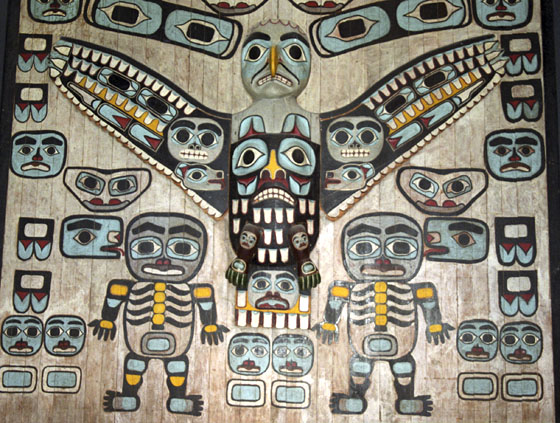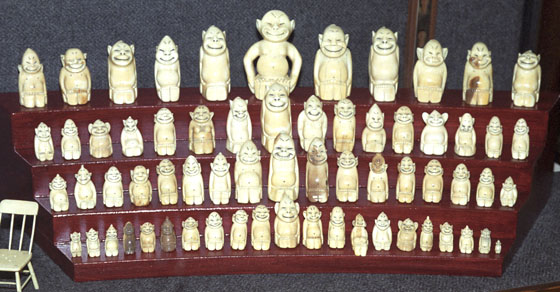Alaska
Day 2 - Friday, 7 September 2001
It was windy and raining when we were ready to start exploring today so we headed to the Alaska Historical Museum about three blocks from the hotel. The $5 entry fee was included in the price of our cruise. We spent a very enjoyable hour or so here.
The Alaska State Museum was established on June 6, 1900, when an Act of Congress created the Historical Library and Museum for the Territory of Alaska. The purpose of the Museum is to collect, preserve and exhibit objects from the territory.
As the official repository of the state's history, the Alaska State Museum is charged with collecting and interpreting a wealth of ethnographic and historical material. From an Aleut thimble basket to the life-sized eagle tree, the Alaska State Museum offers visitors a chance to "see" all the state within four walls.
Some of the more important artifacts at the Museum include a Russian imperial crest of a double-headed eagle. This crest was probably given to a Sitka Native chief by a Russian official during that country's initial settlement of Alaska.
 Exhibit in the Alaska Historical Museum.
Exhibit in the Alaska Historical Museum.
The eagle tree diorama includes young and mature eagles, a brown bear and cub and a variety of small birds found in Southeast Alaska. Visitors ascend to the second floor of the Museum via a circular ramp that surrounds the tree, so they begin at the base and follow it upward. The experience is enhanced by a mural on the walls surrounding the ramp, depicting a Southeast Alaska scene from water level to the top of a typical mountain range.
In 1967, in honor of the centennial of the purchase of Alaska from Russia, the citizens of Juneau implemented a one percent sales tax to help fund the building of the current museum facility. Juneau subsequently turned over ownership and governance of the Museum to the State of Alaska. Since that time, the Museum's collections have grown from 5,500 to 23,000 objects. The Alaska State Museum was accredited by the American Association of Museums in 1975 and was re-accredited in 1987.
The Northwest Coast Indians -- Tlingit, Haida and Tsimshian -- are presented in a gallery constructed of Sitka spruce wood to resemble a clan house, housing various artifacts. The Wolf house posts and Frog house posts were originally designed as roof-supporting posts -- these come from Sitka and Klukwan, respectively.
The museum has a caftan (robe) and hat believed to have been presented to a Native chieftain by a Russian governor. Personal objects from the period, icons and a large samovar (tea kettle) are also included in this portion of the exhibit. A 34-feet-long umiak (boat) is the focus of the Eskimo gallery. Hunting and fishing implements made of ivory, bone, wood and medal are also featured in this exhibit, as are grass baskets. Drums of animal skin and wood indicate the importance that these people place on dance. This exhibit space also has several items of traditional clothing, including parkas of bird skins and ground squirrel. There is also a diorama with a traditional-style kayak and information on the styles of kayaks made throughout the circumpolar region.
The Eskimos began carving ivory Billikens in the early 1900s. The Billiken was introduced into Alaska by a store keeper on Diomede Island. He gave the statuette to an Eskimo, Angokwaghuk, nicknamed "Happy Jack, " who was probably one of the most famous ivory carvers of all time. The Billiken is regarded by the Eskimos as a good luck symbol. Luck is supposed to be generated by ownership of a Billiken in any form. To bring greatness of health, happiness and good fortune one must rub his belly twice a day, always thinking of others, and wishing them " good things!"
 Billikens are Eskimo good luck symbols.
Billikens are Eskimo good luck symbols.
Russian explorers first came to Alaska in 1741. Their accounts of the rich sea otter furs drew traders and hunters to the new land. Russia established several major trading posts during its reign of almost 130 years. Political pressures and the overhunting of the sea otter led Russia to sell Alaska to the United States in 1867 for $7.2 million.
Some of the more important artifacts at the Museum from this time include a Russian imperial crest of a double-headed eagle. This crest was probably given to a Sitka Native chief by a Russian official during that country's initial settlement of Alaska. The Museum also recently acquired a caftan and hat believed to have been presented to a Native chieftain by a Russian governor who was anxious to designate a single liaison for trading purposes. Personal objects from the period, icons and a large samovar are also included in this portion of the exhibit.
The Northwest Coast Indians -- Tlingit, Haida and Tsimshian -- are presented in a gallery constructed of Sitka spruce wood to resemble a clan house, housing various artifacts. The Thunderbird Screen, a wooden painted panel, was made for the Thunderbird House in Yakutat, Alaska, in the early 1900s. The Wolf house posts and Frog house posts were originally designed as roof-supporting posts -- these come from Sitka and Klukwan, respectively. This part of the exhibit also contains one of the famous Chilkat blankets, bentwood boxes and the top of the Lincoln Totem, a totem pole whose carver evidently used a photograph of the president as a model.
 Most travel in Alaska is
by plane or boat. That's our cruise ship in the background.
Most travel in Alaska is
by plane or boat. That's our cruise ship in the background.
Websites: